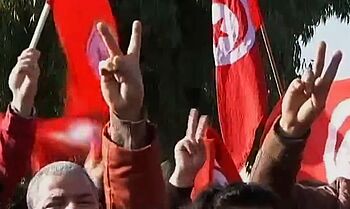Tunisia is hardly bigger than Nicaragua. And yet many hopes are pinned on the Mediterranean state where the Arab Spring began in 2011. After the fall of the dictatorship under President Ben Ali, the country underwent a deep process of democratization. During this time, it also began to enthusiastically examine its past. But the results have thus far only been modest.
Where the Arab Spring began

Tunisia – officially the Republic of Tunisia – is a country in North Africa that borders the Mediterranean Sea. Some 11 Million people live here on an area of nearly 164,000 square kilometers. The population is 98 percent Muslim.
The former French colony gained its independence in 1956 and became a republic the following year. However, under President Habib Bourguiba, who was elected in 1959, Tunisia quickly evolved into a dictatorial state ruled by a single party. This did not change when Prime Minister Zine el-Abidine Ben Ali had him deposed in 1987 and declared himself his successor. During his 24-year rule, tens of thousands of people were arrested, mostly Islamists, but also Communists and military personnel. Increased restrictions were placed on freedom of speech, the press and assembly. In addition, Ben Ali’s family used the state to greatly enrich itself.
In January 2011, the population in Tunisia engaged in massive protests. The dictator fled to Saudi Arabia. His removal from power triggered uprisings in other countries in a movement which came to be known as the Arab Spring. Ben Ali’s party, the Constitutional Democratic Rally (RCD), was banned in March 2011. Free elections to the Constituent Assembly were held in October. Former RCD functionaries were not allowed to run for office. The country adopted a new constitution in 2014.
The deputies also set up a Commission for Truth and Dignity. It spent five years investigating human rights violations under Ben Ali and Bourguiba. But its work was increasingly drawn into party conflicts.
Following several terrorist attacks, a state of emergency was declared in Tunisia in late 2015. The country is nevertheless still viewed as the only democratically governed state in the Arab world. The National Dialogue Quartet, consisting of the General Labor Union, the Confederation of Industry, the Order of Lawyers and human rights activists, was awarded the Nobel Peace Prize in 2015.
Republic of Tunisia

Area: | 163,610 km² |
|---|---|
Inhabitants: | 11.5 million (2018, estimate) |
Population growth: | 1.12 % annually (2017) |
Population density: | 71 inhabitants per km² |
Seat of government: | Tunis |
Official language: | Arabic |
Political system: | Semi-presidential democracy |
Head of state: | President Kais Saied (since 2018) |
Head of government: | Minister President Elyes Fakhfakh (since 2018) |
Freedom status: | 70/100 |
GDP per capita: | 12,384 USD (adjusted for purchasing power, 2018) |
(ኢትዮጵያ)
(تونس)
(République démocratique du Congo)
(الصومال)
(جيبوتي)
(مصر)
(الجزائر)
(Côte d'Ivoire)
(إرتريا)
(The Gambia)
(Cameroun)
(République du Congo)
(ليبيا)
(المغرب)
(موريتانيا)
(Moçambique)
(السودان)
(South Africa)
(South Sudan)
(تشاد)
(الصحراء الغربية)
(République centrafricaine)